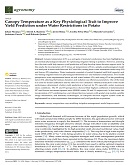Mostrar el registro sencillo del ítem
Canopy Temperature as a Key Physiological Trait to Improve Yield Prediction under Water Restrictions in Potato
| dc.contributor.author | Ninanya, Johan | |
| dc.contributor.author | Ramírez, David A. | |
| dc.contributor.author | Rinza, Javier | |
| dc.contributor.author | Silva-Díaz, Cecilia | |
| dc.contributor.author | Cervantes, Marcelo | |
| dc.contributor.author | García, Jerónimo | |
| dc.contributor.author | Quíroz, Roberto | |
| dc.date.accessioned | 2021-07-22T21:22:23Z | |
| dc.date.available | 2021-07-22T21:22:23Z | |
| dc.date.issued | 2021-07-20 | |
| dc.identifier.uri | https://doi.org/10.3390/agronomy11071436 | |
| dc.identifier.uri | https://repositorio.catie.ac.cr/handle/11554/11128 | |
| dc.description.abstract | Canopy temperature (CT) as a surrogate of stomatal conductance has been highlighted as an essential physiological indicator for optimizing irrigation timing in potatoes. However, assessing how this trait could help improve yield prediction will help develop future decision support tools. In this study, the incorporation of CT minus air temperature (dT) in a simple ecophysiological model was analyzed in three trials between 2017 and 2018, testing three water treatments under drip (DI) and furrow (FI) irrigations. Water treatments consisted of control (irrigated until field capacity) and two-timing irrigation based on physiological thresholds (CT and stomatal conductance). Two model perspectives were implemented based on soil water balance (P1) and using dT as the penalizing factor (P2), affecting the biomass dynamics and radiation use efficiency parameters. One of the trials was used for model calibration and the other two for validation. Statistical indicators of the model performance determined a better yield prediction at harvest for P2, especially under maximum stress conditions. The P1 and P2 perspectives showed their highest coefficient of determination (R2) and lowest root-mean-squared error (RMSE) under DI and FI, respectively. In the future, the incorporation of CT combining low-cost infrared devices/sensors with spatial crop models, satellite image information, and telemetry technologies, an adequate decision support system could be implemented for water requirement determination and yield prediction in potatoes. | es_ES |
| dc.language.iso | en | es_ES |
| dc.relation.ispartof | Agronomy, Volumen 11, (2021) | es_ES |
| dc.rights | info:eu-repo/semantics/restrictedAccess | es_ES |
| dc.subject | TEMPERATURA | es_ES |
| dc.subject | DOSEL | es_ES |
| dc.subject | RENDIMIENTO | es_ES |
| dc.subject | PAPA | es_ES |
| dc.subject | PREDICCION | es_ES |
| dc.subject | TRATAMIENTO DE AGUAS | es_ES |
| dc.subject | BALANCE HIDRICO | es_ES |
| dc.subject | MEJORA DE CULTIVOS | es_ES |
| dc.subject | BIOMASA | es_ES |
| dc.subject | COSECHA | es_ES |
| dc.title | Canopy Temperature as a Key Physiological Trait to Improve Yield Prediction under Water Restrictions in Potato | es_ES |
| dc.type | Artículo | es_ES |
Ficheros en el ítem
Este ítem aparece en la(s) siguiente(s) colección(ones)
-
Publicaciones y documentos [4424]


